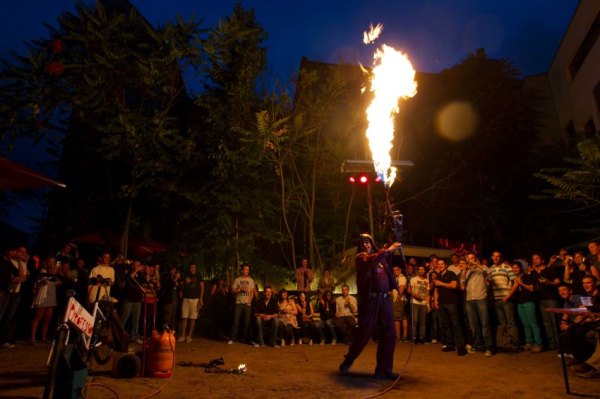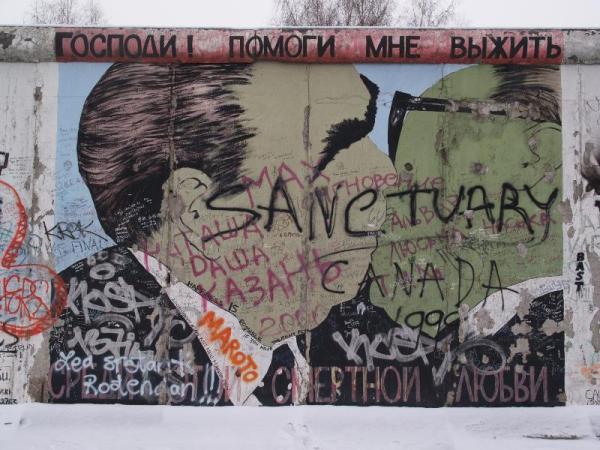Tacheles: Counterculture vs Capitalism
Berlin is no stranger to facing major political and social crises. There was never a period of recovery from WWII and the Nazi regime. It immediately faced those consequences, which prompted the Cold War. The city was physically and politically divided from that point until 1989. With reunification, Germany -specifically Berlin- confronted an identity crisis and a city in ruins, which led to uncertainty when it came time for reconstruction.
Many people took one of two sides: preserve as much as possible or start a fresh slate and build new. Many political battles were fought over preservation vs. new construction. New construction tended to pit left-wing squatters and politicos against Germany’s new capitalism. Ironically, post-war German reconstruction looked a lot like the modernist monumental vision of Hitler.
The major commercial center, Potsdamer Platz, was planned and built immediately after the wall fell. Despite commercial efforts like Potsdamer, Berlin has cultivated an avant-garde arts scene, reminiscent of 1980s New York. Forward-thinking art and design has a home in Berlin. It has become a cultural capital for Europe. This gritty and edgy scene has become Berlin’s historically appropriate post-wall identity. The unfortunate fate of 1980s New York is paralleled with the AIDS epidemic and mostly the “Disney-fication” of the city by the Giuliani administration. Berlin is in a similar predicament as New York was in the early 90’s. People need to fight to preserve Berlin, and brand it as an arts-city. We can take a lesson from New York and prevent homogenous development that could destroy the identity that Berlin has been able to embrace after hundreds of years of identity crises.
A significant example of a Giuliani-esque attempt to surrender culture to commercial developers is the old Tacheles department store. Squatters at the abandoned Tacheles have become synonymous with the Berlin art scene. Squatters have flourished in post-wall Berlin. The trend started fresh off the opening of the wall, when East Berliners inundated the west looking for opportunity, therefore emptying many buildings and prompting debates of possession. Today, most squatters manage activities for artists and political groups in these derelict buildings. Artists at Tacheles confront the concept of public domain. The site becomes a public space for artists and admirers. Currently, developers are hoping to turn this hallowed ground into a major real estate property. The “I Support Tacheles” website claims that the building attracts a “high number of visitors [and is] an economic cornerstone of the district”. They are demanding “the small plot of the Kunsthaus transfer by lease to a public foundation – Tacheles secure”. Tearing down Tacheles, a cultural and even tourist destination, and shifting it to a commercial development damages Berlin’s art persona which it struggled to embrace ever since graffiti artists took to the wall years ago. Even the so-called “preserved” East Side Gallery -a historic remnant from the Berlin Wall graffiti art scene- is not protected. Russian artist, Dmitri Vrubel, famous for painting the Brezhnev/Honecker kiss on part of the East Side gallery, is fighting for his artwork to be maintained. This is part of a greater question of what are the rights of those who produce public art. Kani Alavi, of an artist initiative group, discusses the difficulties with the public art gallery, “Under German law, art that is created in a public space does not enjoy copyright protection.” However, the group plans to take the issue up in court to raise awareness.
We face a global identity crisis due to the moneymaking machine. Germans “are wondering with increasing urgency where they really come from and where they belong,” said Ortwin Renn, a Stuttgart-based sociologist. Why take away what gives Berlin a link to its past and a path to its future? We don’t need another Generic City.





Nice post.
What struck me so much about Berlin is it’s ability to radically re-invent itself time and time again. The neighborhoods are constantly bringing in new identities and cultures. The city exists as a system of enclaves as well, which adds to the idea that the city can constantly re-invent the wheel, almost like self autonomous bodies or states within what is known as “Berlin.” You mention the comparison between New York’s “scene” in the 1980’s and 1990’s. I would love to see a comparison in graphic form, maybe analyzing geography, social and political domains and the results. What are other cities?
Here is an interview in some obscure Architecture Design profile book from nearly 20 years ago
Named: Berlin City Forum_ Jacques Derrida, Kurt Forster, Wim Wenders (with Takashi Asada)
Takashi Asada:
“Now going back to my impression of Berlin under the wonderful guidance of Kurt Forster, I was especially struck by the polycentric and multilayered structure of the city. It is not a city governed by a single centre or two or three centres, it is a particularly polycentric city. Kurt Forster talked about islands or enclaves, each with its proper characteristics. These enclaves or islands are not only isolated from one another, there are inter-spaces between them and we can see a kind of multi-layered overlapping of many dimensions.”
The article goes on and is pretty interesting. They are framing Berlin from a , “how do we look at this city as a capital, after it has been fractured” kind of way.
Anyway, good work, and Berlin is fascinating. Dig and dig and dig.
gabe